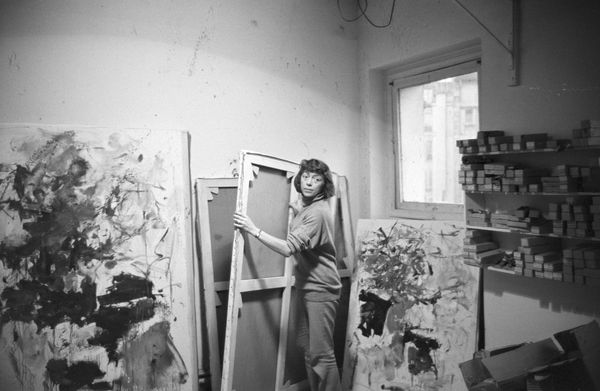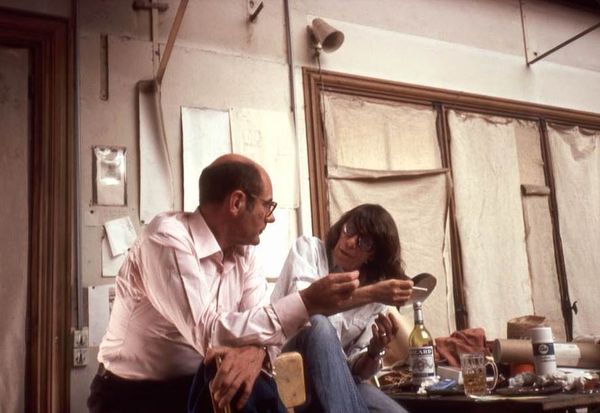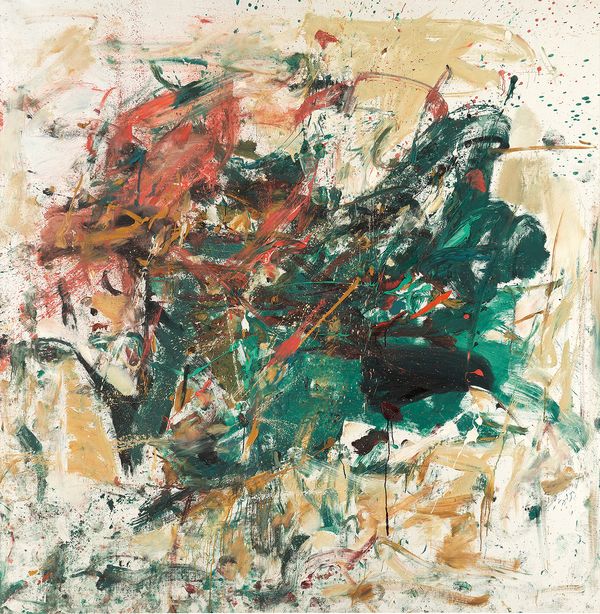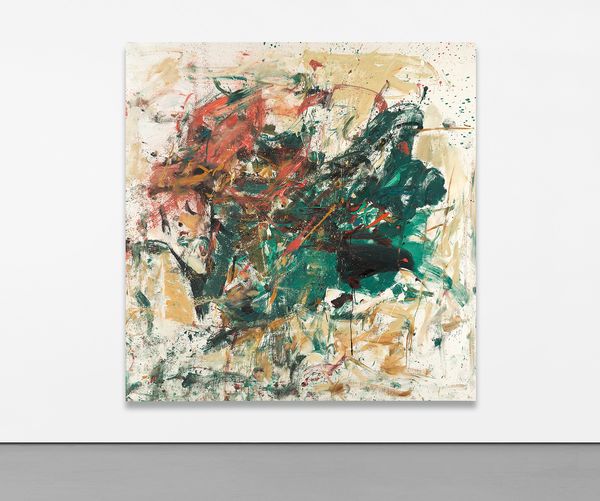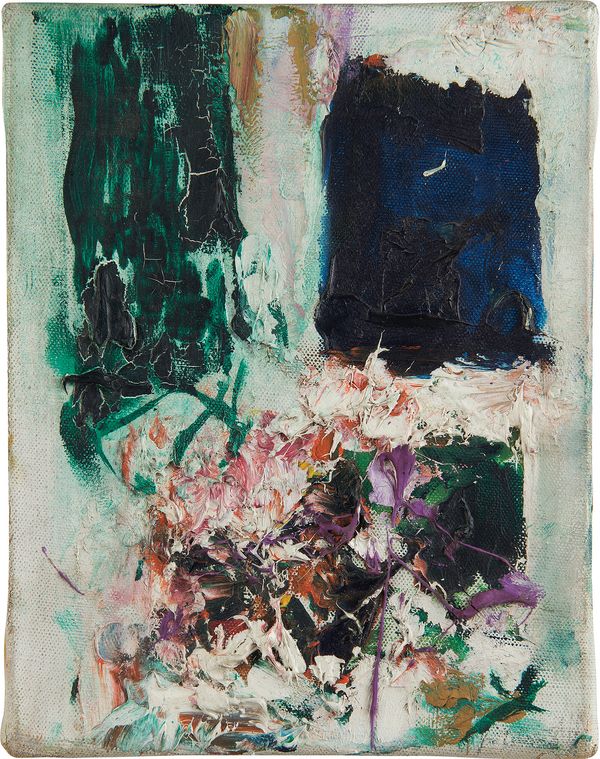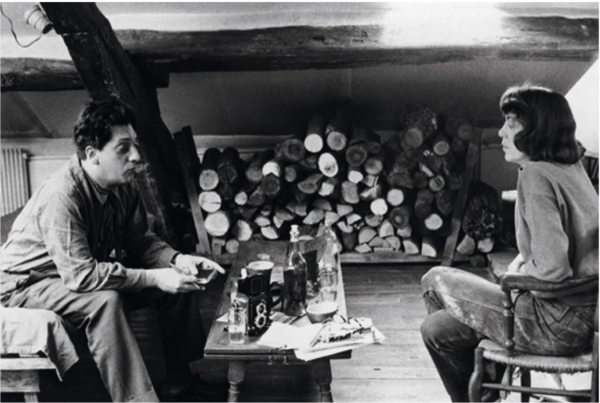Joan Mitchell in her Paris studio, 1962. Photo by BIOT Jean-Pierre/Paris Match via Getty Images, Artwork © Estate of Joan Mitchell.
ROBERT MANLEY: Jill, tell us about your connection to Joan Mitchell’s painting, 'Noël,' 1961-1962.
JILL WEINBERG ADAMS: I was at the Xavier Fourcade Gallery during the '70s and '80s, and this painting was exhibited there in 1985, as part of a very important exhibition of paintings from 1961 and '62. They had never been seen in New York before and only been exhibited only once previously.
Joan Mitchell and Xavier Fourcade in the artist's studio, circa 1983.
In the summer of 1979, Xavier was in Paris during which time he visited Joan and that appears to have been the occasion when Joan told him there is a group of paintings that were stored at Klipstein and Kornfeld in Bern. They had remained there, after having been originally exhibited there in 1962. Xavier immediately went about retrieving them from Switzerland. Most of them were held back until the right opportunity to devote a show specifically to these paintings. The Fourcade show was “Joan Mitchell: The Sixties,” held April 3rd to May 4th in 1985.
Joan Mitchell Noël, 1961-1962. Estimate: $9,500,000-12,500,000.
20th Century & Contemporary Art Evening Sale.
RM: Do you remember the first time you saw 'Noël' and this whole body of work?
JWA: It would have been in the warehouse when they arrived after shipment. I was the person who accompanied the photographer to the warehouse and had the experience of seeing all 13 of the paintings, including Noël.
In Michael Brenson’s review in The New York Times, he described the power of the paintings, their lyricism, their centers like two squalling cats. He made the point that a lot of these paintings seem to revolve around the conflict between two primary areas of activity—and you certainly see that in Noël. The juxtaposition of the underlying green mass becomes the stage set for establishing the chromatic contrast between this hot, bright orangey-red and the whole range of greens.
In this period of time, between 1960 and 1962, Joan was exploring and navigating a whole different method and range of paint application, from throwing paint on the canvas to squeezing paint directly onto the canvas to using brushes. It's also said she used her fingers, I’m not sure about that. There's a tangle of staining and impasto and articulated brushstrokes and blurry areas that are distinctive in this period. Noël has a kind of a limpid, liquid, airy quality that extends to the brushy, washy passages - I call them atmospheres - that surround the central composition. And those are the things that knit the painting together. She described the figure/ground relationship as the only formal issue in painting that interested her. And that really has to do with establishing a foundation, building on top of it, and then connecting the entirety to the format of the canvas itself.
RM: Did Joan ever talk about her work from this period?
JWA: I helped prepare for her first traveling retrospective exhibition, which opened in 1988 and traveled through 1989. The curator was an art historian named Judith Bernstein. Judith elicited from Joan the comment that these paintings were “very violent and angry paintings,” though at the same time, there is a lightness and a lyricism and a breadth to them.
But in looking back on these paintings, Joan would also have remembered what a difficult time it was in her life. Her father was ill, her mother had been diagnosed with cancer. She was going through her whole drama with Riopelle, settling in Paris, the art world changing, the Abstract Expressionist community fragmenting, the rise of pop art. There is a vigor and an expressiveness, in the way that this painting and other paintings from this period are created, that does give them their storms. They have an emotional tone that does, to some extent, express a certain kind of contrast between darkness and light, between lovely experiences like a garden party in the afternoon, (which is the title of one of the paintings in the series) to another painting in the series called Grandes Carrières, a section of Paris known for the cemetery located in the abandoned quarries. So there are hints of death as well as memories of a garden of light and loveliness.
I think, that Noël has a specificity of its color palette that's not true of all of the other paintings—more than ones like Grandes Carrières at the Museum of Modern Art. It's a little bit more violent, it's a little bit more reddish. It has an overall tonality and a narrower contrast range. Whereas this painting really does sparkle with the juxtaposition of near complementary colors. Joan's sense of color was very nuanced and she was really sensitive to the specific hues that she was using.The inclusion of ochres and ambers and earth tones and greys were always very important in setting off her use of color.
RM: 'Noël' was included in the 1962 exhibition at Klipstein and Kornfeld, can you tell us about that?
JWA: The 1962 show that Joan Mitchell had with Klipstein and Kornfeld in Bern, Switzerland was a very, very important exhibition for her. It was an opportunity to show a larger, interrelated and extraordinarily dynamic body of work in Europe with the support of a really established, highly regarded historic organization that was both publisher, auction house, and exhibition gallery. It appears likely that her connection with Kornfeld and Klipstein came out of her close friendship with Sam Francis, who was already working with them.
Joan Mitchell Noël, 1961-1962 (installation view). Estimate: $9,500,000-12,500,000.
20th Century & Contemporary Art Evening Sale.
RM: Do you have any insight into how Mitchell named her paintings?
JWA: Mitchell loved poetry. She liked the sound of words, such as 12 Hawks at Three O'clock. Her titles came afterward; she didn't start with a title. Sometimes friends would participate in titling sessions. These paintings would have been given titles as they were chosen to leave the studio and go out into the world for the exhibition in Switzerland.
I think it's reasonable to conclude that she chose Noël for this painting because of its juxtaposition of green and this reddish color that would not be atypical for her. It is interesting to note that most of the paintings in this group of works were given French titles, but some had English titles. Noël is kind of an interesting case because it's both. There may have been other references. It may be a painting that was finished in the wintertime.
I paint from remembered landscapes that I carry with me – and remembered feelings of them, which of course become transformed…
— Joan Mitchell
Joan Mitchell Untitled, 1975. Estimate: $80,000-120,000.
20th Century & Contemporary Art Day Sale, Morning Session.
RM: Can you talk about the paints Joan used and how she painted?
JWA: Mitchell's paintings would tend to begin with a washy underlayer as an establishment of the composition. In this case, it would be the whole rear ground green that largely ends up getting covered up. When she was starting a canvas, she was beginning it generally with broad brushes and a thinned down paint. That established an environment in which drips are inevitable. During the ‘50s where one sees glimpses of drips, she tended to continue to build her structure on top of the drips and ultimately covered overall, but clearly she allowed them in these paintings.
By the time you see drips for the first time in a painting like this and others of this period, she appears to be taking a loaded brush and throwing it at the canvas and accomplishing this dollop of paint followed by a trail. Compared to works from four or five years earlier—which tend to be much more all over, more architectural—in this period, she is exploring and navigating a whole different method and range of paint application, from throwing paint on the canvas to squeezing paint directly onto the canvas using brushes. This continued the rest of Mitchell's life as a painter, which went on another 30 years. She alternated between pulling her compositions into the center and extending them and expanding them back around to the boundaries. This is the first time that she gathered the composition into these knots of activity.
Joan Mitchell always used very high-quality painting materials. She wasn't like de Kooning or Kline who just sometimes used whatever they had at hand. It was always really important to her to use the best oil pigments in order to achieve the desired results. She worked as carefully as she could, and knew to put thick over thin and not thin over thick. But she did really push her pigments around sometimes in ways that are impossible, painting thicker than paint is really engineered to be and she oftentimes pushed the capacity of the paint to the brink. Noël is in really remarkably good condition. During its initial period of drying and stabilizing, it wasn't moving around, it was presumably in some kind of a reasonably temperature-controlled environment. So it could sit. And then, because it only changed hands a couple of times and has been in a private collection where it's obviously been loved for such a long time, it hasn't been subjected to the indignities of poor handling and temperature changes and all of that.
Jean-Paul Riopelle and Joan Mitchell photographed in their apartment-studio on Rue Frémicourt, Paris, 1963.
RM: Were there special challenges Joan faced as a woman?
JWA: She might stand in front of a painting, nudge a companion and say, "Not bad for a lady painter”. She was never not aware of the reality that her gender, her identity as a woman, put her in a category that she bridled against, that she worked to not allow to impede her. She really insisted that it didn't limit what she did or how she approached it. I sometimes think that it affected Joan more in her social and professional life than it did in the studio. In the studio, it didn't matter at all what her gender was.
I feel strongly that one of the reasons that Joan Mitchell's work is increasingly recognized, increasingly held in high regard is because of how she authentically viewed painting. Her goal for her paintings was that a painting should be a repository that reflects some aspect of lived experience. So that like a great poem or a Shakespearean sonnet or a great piece of musical composition, the greatest of them are never dated. They're always alive. We don't care about this painting only because it's an important example of a historical period. Although we do care about it because of that, we really primarily care about this painting because of the way it's alive in front of our eyes.
